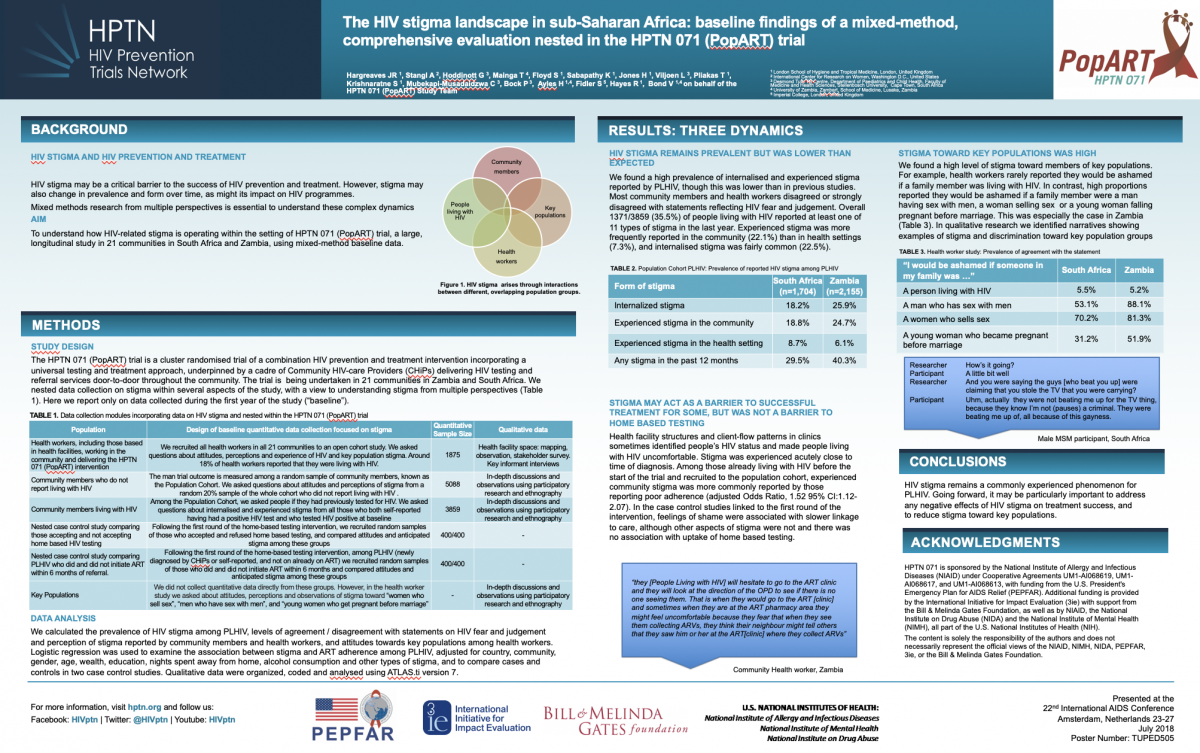Download a PDF of the presentation here
Stigma is a well-documented barrier to health seeking behaviour, engagement in care, and adherence to treatment across a range of health conditions globally. In order to halt the stigmatisation process and mitigate the harmful consequences of health-related stigma, it is critical to have a theoretical framework to guide intervention development, measurement, research and policy.
It’s not “all in your head”: critical knowledge gaps on internalized HIV stigma and a call for integrating social and structural conceptualizations
Internalized HIV stigma is a public health concern as it can compromise HIV prevention, care and treatment. This paper has two aims.
The Health Stigma and Discrimination Framework: a global, crosscutting framework to inform research, intervention development, and policy on health-related stigmas
Stigma is a well-documented barrier to health seeking behaviour, engagement in care and adherence to treatment across a range of health conditions globally. In order to halt the stigmatization process and mitigate the harmful consequences of health-related stigma, it is critical to have an explicit theoretical framework to guide intervention development, measurement, research, and policy.
“Being seen” at the clinic: Zambian and South African health worker reflections on the relationship between health facility spatial organisation and items and HIV stigma in 21 health facilities, the HPTN 071 (PopART) study
People living with HIV (PLHIV) often report experiencing a fear of “being seen by others” when in health facilities, and this can sometimes adversely affect engagement in care and adherence to anti-retroviral treatment. To reflect and address the relationship between health facilities and HIV stigma, this paper focuses on the role of the spatial organisation of health facilities, and HIV services within them, and on items linked to those HIV services.
Findings
Associations between sex work laws and sex workers’ health: A systematic review and meta-analysis of quantitative and qualitative studies
Sex workers are at disproportionate risk of violence and sexual and emotional ill health, harms that have been linked to the criminalisation of sex work. This paper synthesised evidence on the extent to which sex work laws and policing practices affect sex workers' safety, health and access to services, and the pathways through which these effects occur.
The authors searched bibliographic databases between 1 January 1990 and 9 May 2018 for qualitative and quantitative research involving sex workers of all genders and terms relating to legislation, police, and health.
The HIV stigma landscape in sub-Saharan Africa: baseline findings of a mixed-method, comprehensive evaluation nested in the HPTN 071 (PopART) trial
Individual and community-level risk factors for HIV stigma in 21 Zambian and South African communities: analysis of data from the HPTN071 (PopART) study
HIV stigma is present whenever HIV infection is linked to negative stereotypes that mark a person living with HIV as different from the rest of the population; a separation of ‘them’ from ‘us.’ This separation then leads to status loss, which can result in negative outcomes for people living with HIV (PLHIV). Stigma experienced by PLHIV can include being gossiped about, insulted or physically assaulted in communities and healthcare settings.
Women and girls and HIV
On International Women's Day 2018, UNAIDS published a report detailing data and analysis of the ways in which women continue to bear the brunt of the HIV epidemic.
The opening statement, written by Michel Sidibé, Executive Director of UNAIDS, recognises the contribution of activists and organizations working for gender equality and women's empowerment across the world and makes a call to action to work collectively:
Can mother-to-child transmission of HIV be eliminated without addressing the issue of stigma? Modeling the case for a setting in South Africa
Stigma and discrimination continue to undermine the effectiveness of the HIV response. Despite a growing body of evidence on the negative relationship between stigma and HIV outcomes, there are insufficient data available on the prevalence of stigma and its impact. This paper presents a probabilisic cascade model to estimate the magnitude of the impact that stigma has on mother-to-child transmission.
Impact case study: HIV stigma reduction in India
Stigma remains a major barrier to HIV prevention and treatment. The Asia Regional Office of the International Center for Research on Women (ICRW-ARO) adapted a global framework for understanding and addressing stigma in five different population settings in India and evaluated its impact.




